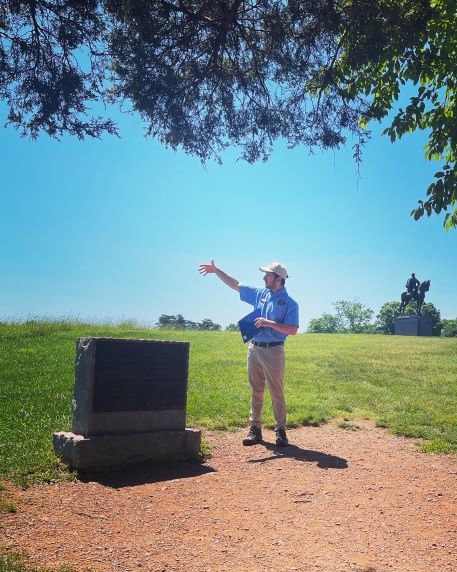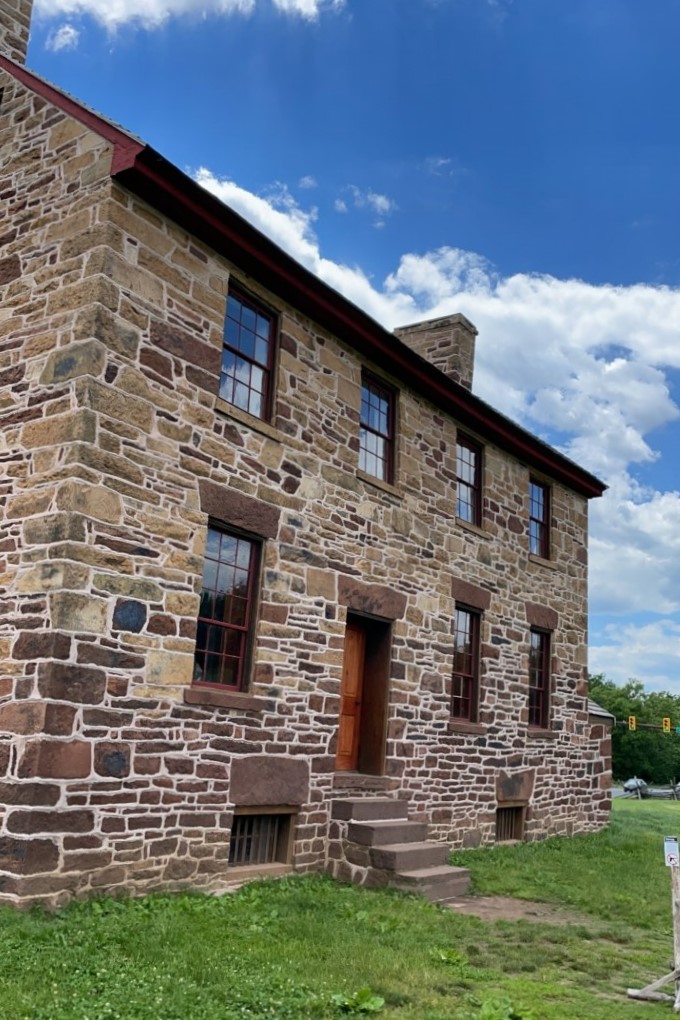Reflections from Manassas: Daniel Sunshine Discusses His Internship at Manassas National Battlefield Park
by Daniel W. Sunshine | | Wednesday, September 14, 2022 - 13:46

 The last few months at Manassas National Battlefield Park have been educational, inspirational, and quite simply, a lot of fun. I am grateful to the Nau Center for providing this opportunity because it allowed me to apply the skills I learned in graduate school in a very different context—that of public history. The core skillset is universal: absorb primary and secondary sources and then convince an audience why it is important to their lives. The difference is that while I had an entire semester to teach my undergraduates, I had just 45 minutes to give a battlefield tour that was both entertaining and profound. Designing my program was a fun challenge. Using the landscape of the park, I explained how the battle unfolded but more importantly, what brought Americans to Henry Hill to wage the first major battle of the Civil War. In doing so, I engaged visitors in deeper conversations about the role of slavery in the United States and why the ideology of Union was such a powerful motivation for the Federals.
The last few months at Manassas National Battlefield Park have been educational, inspirational, and quite simply, a lot of fun. I am grateful to the Nau Center for providing this opportunity because it allowed me to apply the skills I learned in graduate school in a very different context—that of public history. The core skillset is universal: absorb primary and secondary sources and then convince an audience why it is important to their lives. The difference is that while I had an entire semester to teach my undergraduates, I had just 45 minutes to give a battlefield tour that was both entertaining and profound. Designing my program was a fun challenge. Using the landscape of the park, I explained how the battle unfolded but more importantly, what brought Americans to Henry Hill to wage the first major battle of the Civil War. In doing so, I engaged visitors in deeper conversations about the role of slavery in the United States and why the ideology of Union was such a powerful motivation for the Federals.
It was a privilege to work with the National Park Service. Our park was completely free of charge. I met people from all over the country and all over the globe—everyone from Irish vacationers to recently arrived Afghans. They could have been anywhere else, but all chose to spend their free time with us, learning about the past. There was something very pure in that, and it gave me a sense of purpose each day. People visited for different reasons, and part of my job was just to listen to them. I had countless long conversations with visitors as they told me why the park was important to them. Sometimes these people expressed interpretations of history or political opinions I did not agree with. While I would politely correct misinformation, never did I respond with personal disdain. I was a public servant. My job was to meet people where they were and to help them learn by presenting new perspectives or evidence.
A similar dynamic also applied to working with young children. My usual talking points would just elicit boredom. Instead, I just tried to make history exciting and tangible. We had a mock artillery chest, and kids’ faces would light up when they got to hold a Parrott shell. We did a special program teaching kids about the Signal Corps, showing them how to send messages using Civil War signal flags (which played a decisive role at the Battle of Bull Run). One of my favorite things was to ask young children what food they would take on a long hike (“pizza” was the most common answer). I would give them a stale piece of Civil War hardtack to bang on the ground, and then add to their disgust by telling them that the soldiers’ hardtack was often full of bugs! It was silly, but little things like that engaged a child’s imagination, and I hope, helped them get curious about the past.
Beyond leading battlefield tours, I had a number of responsibilities. One highlight was doing museum inventory with curator Jim Burgess. Having worked at the park since the 1980s, Jim has an encyclopedic knowledge of First and Second Manassas, as well as of the material culture of the Civil War. The inventory went a little slower than it could have, because I kept asking him to explain all of the artifacts we catalogued (a West Point diploma, a Zouave fez, and a rifled musket fished out of Bull Run in the 1970s were some of my favorites). He quizzed me on artillery pieces as we logged all 41 cannons throughout the park, all of which represent Union or Confederate batteries. Artillery was so decisive to Civil War battles, and it was enrichening to be able to spot an artillery piece and immediately understand how its range and positioning would have affected the battle. It gave me a new respect for how difficult it was to command a Civil War army, requiring generals to make rapid hard choices (like where to place artillery) with incomplete information, as their army stretched out for miles around them. I also contributed written content to the Park, including entries for a new self-guided walking tour and a longer piece for the website entitled “Slavery and the Origins of the American Civil War.”
 Once a week, I was in charge of a famous landmark: the Stone House at the crossroads of the Warrenton Turnpike and Sudley Road. It was filled with wounded soldiers in both battles. At Second Manassas, Major General John Pope’s grand plan to smash Lee’s army had failed, and he was now in retreat. The 5th New York had the critical and deadly job of stemming one of the largest Confederate assaults of the war, buying time for the U.S. army to fight another day. Two soldiers from the 5th New York, Charles Brehm and Eugene P. Geer, took wounds and ended up lying next to each other on the floor of the Stone House. Fearing death, they carved their names into the floor. The seventeen year old Geer died several weeks later, but Brehm recovered and lived to an old age. It was a sobering reminder of how this war was the end of some people’s stories, while for others, it was an important but short part of a rich life. Visitors were always moved by Brehm and Geer. One day, a man came in who told me his ancestor was in the 5th New York and survived Second Manassas. He would have known Brehm and Geer. He would have been caught in that same hellish fight on August 30, 1862. Had he not survived, his descendent would not be in the Stone House having a conversation with me. It made me think of the children that Geer never had, and all they might have accomplished. As a historian, I spend most of my time thinking about the big political and social changes wrought by the Civil War. But meeting this man reminded me not to overlook how the war cruelly altered the course of so many families. The small stories of the war are just as poignant as the major ones.
Once a week, I was in charge of a famous landmark: the Stone House at the crossroads of the Warrenton Turnpike and Sudley Road. It was filled with wounded soldiers in both battles. At Second Manassas, Major General John Pope’s grand plan to smash Lee’s army had failed, and he was now in retreat. The 5th New York had the critical and deadly job of stemming one of the largest Confederate assaults of the war, buying time for the U.S. army to fight another day. Two soldiers from the 5th New York, Charles Brehm and Eugene P. Geer, took wounds and ended up lying next to each other on the floor of the Stone House. Fearing death, they carved their names into the floor. The seventeen year old Geer died several weeks later, but Brehm recovered and lived to an old age. It was a sobering reminder of how this war was the end of some people’s stories, while for others, it was an important but short part of a rich life. Visitors were always moved by Brehm and Geer. One day, a man came in who told me his ancestor was in the 5th New York and survived Second Manassas. He would have known Brehm and Geer. He would have been caught in that same hellish fight on August 30, 1862. Had he not survived, his descendent would not be in the Stone House having a conversation with me. It made me think of the children that Geer never had, and all they might have accomplished. As a historian, I spend most of my time thinking about the big political and social changes wrought by the Civil War. But meeting this man reminded me not to overlook how the war cruelly altered the course of so many families. The small stories of the war are just as poignant as the major ones.
I took this summer internship as a fun opportunity while I finished graduate school, before I began a post-doctorate at Virginia Commonwealth University. And while it was a nice change of pace from my usual routine of research, writing, and teaching, it was unexpectedly profound. I formed a much more tangible connection to the Civil War, and it helped reignite my sense of wonder for this dramatic period of American history.
Author biography: Daniel W. Sunshine earned his PhD from the University of Virginia in 2022 and currently serves as a Postdoctoral Fellow with the East Marshall Street Well Project at Virginia Commonwealth University
